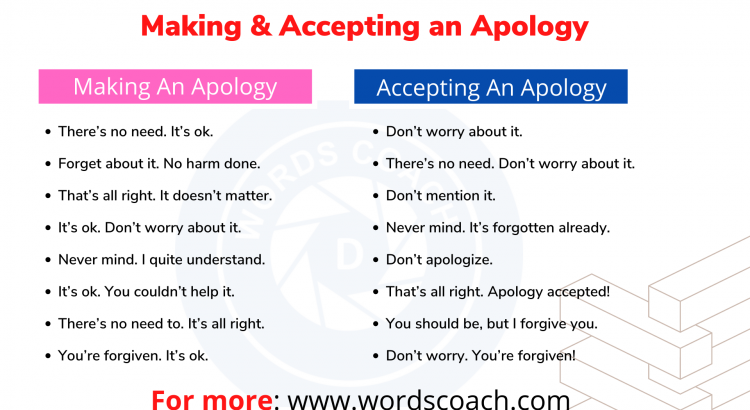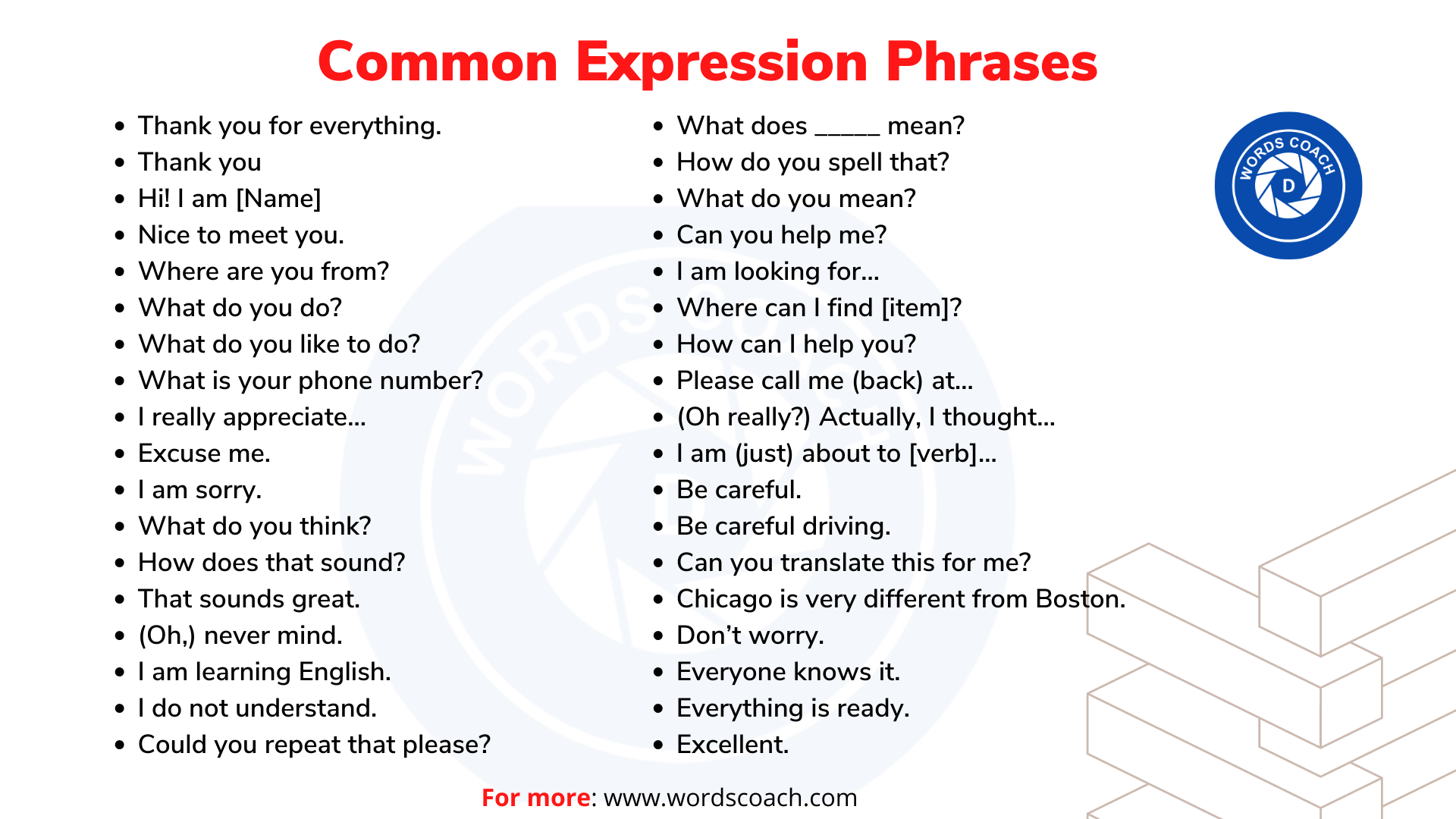How To Make And Accept An Apology In English
When you realize you’ve made a mistake or hurt someone, it’s important to own up to it and offer a sincere apology. The key to a good apology lies in being genuine and taking responsibility. Here’s a step-by-step guide to making an apology:
Acknowledge the Mistake
Begin by acknowledging what you did wrong. The person you are apologizing to will appreciate that you understand the issue.
- Examples:
- “I’m really sorry for forgetting about our meeting.”
- “I apologize for the misunderstanding earlier.”
- “I’m sorry for the inconvenience I caused.”
Express Remorse
Show that you feel regret and that you genuinely care about how the other person feels.
- Examples:
- “I feel terrible about what happened.”
- “I deeply regret my actions.”
- “I didn’t mean to hurt you, and I’m truly sorry.”
Offer a Solution or Compensation
If appropriate, offer a solution or suggest how you plan to fix the situation.
- Examples:
- “I’ll make sure it doesn’t happen again.”
- “I will correct the mistake as soon as possible.”
- “Let me know if there’s anything I can do to make up for it.”
Ask for Forgiveness (Optional)
Asking for forgiveness shows humility but isn’t always necessary. It can be done if you feel it is appropriate for the situation.
- Examples:
- “Please forgive me for my mistake.”
- “I hope you can accept my apology.”
Sincere Closing
Close your apology with a sincere expression of regret and a promise to do better in the future.
- Examples:
- “Again, I’m very sorry, and I’ll make sure this doesn’t happen again.”
- “Thank you for understanding. I truly regret what happened.”
How to Accept an Apology in English
When someone apologizes to you, it’s just as important to know how to respond graciously, whether or not you are ready to forgive them immediately. Here’s how to accept an apology:
Acknowledge the Apology
Start by acknowledging their apology. This shows that you have heard them and recognize their effort to make amends.
- Examples:
- “Thank you for your apology.”
- “I appreciate you apologizing.”
- “It’s good to hear you say that.”
Respond Depending on How You Feel
How you respond next depends on how you feel about the situation. If you’re ready to forgive, let them know. If you need more time, it’s okay to express that too.
- If you accept the apology:
- “I accept your apology.”
- “We all make mistakes, it’s okay.”
- “No hard feelings.”
- If you need time:
- “I need a little time, but I appreciate your apology.”
- “I’m still hurt, but I’m glad you said something.”
- “Let’s talk about this more later.”
Be Kind and Respectful
Whether you accept the apology immediately or not, it’s important to stay calm and respectful in your response.
- Examples:
- “I know it wasn’t intentional. Thank you for saying sorry.”
- “I appreciate your honesty.”
Let Go and Move Forward
Once an apology is made and accepted, it’s best to let the issue go and move on. Holding onto the past can strain the relationship further.
- Examples:
- “Let’s move forward from here.”
- “I’m glad we cleared that up.”
Ways to Say “I’m Sorry” in English
List of different ways to say I’m Sorry. Learn these I’m Sorry to enhance your vocabulary and improve your communication skill in English.
APOLOGIES: making and accepting apologies
How to Make and Accept an Apology in English! In our daily conversation, we sometimes have to ask for an apology or to accept someone’s apology. It is a very common thing in our life. Saying “Sorry” is a cold way to make an apology and similarly “It’s Ok” is the coldest one to accept an apology.
Making An Apology
- I do apologize for
- Excuse me
- I must apologize for…
- Ever so sorry.
- I beg your pardon.
- I apologize for…
- Please, forgive me for my…
- Please forgive me for…
- How stupid/careless/thoughtless of me.
- I apologize.
- I had that wrong.
- I hope you can forgive me.
- I owe you an apology.
- I sincerely apologize.
- I take full responsibility.
- I want to apologize.
- I wanted to tell you I’m sorry.
- I was wrong about that.
- I’d like to apologize.
- I’d like to apologize for how I reacted yesterday.
- I’m (so/very/terribly) sorry.
- My mistake.
- Oh my goodness! I’m so sorry. I should have watched where I was going.
- Oh, my bad.
- I was wrong. Can you forgive me?
- My apologies.
- Please accept my apology for …
- I shouldn’t have…
- My fault, bro (US)
- Sorry about that.
- I shouldn’t have said that. Don’t be mad at me.
- Sorry, my apologies. I had that wrong.
- Sorry. It was all my fault.
- Pardon (me)
- Please accept our (sincerest) apologies.
- Please don’t be mad at me.
- Please excuse my (ignorance)
- I was wrong. Can you forgive me?
- That was wrong of me.
- That’s my fault.
- Whoops! Sorry!
- I beg your pardon
- My bad (US)
- Excuse me for interrupting.
- Pardon me for being so rude.

Accepting An Apology
- There’s no need. It’s ok.
- Forget about it. No harm done.
- That’s all right. It doesn’t matter.
- It’s ok. Don’t worry about it.
- Never mind. I quite understand.
- It’s ok. You couldn’t help it.
- There’s no need to. It’s all right.
- You’re forgiven. It’s ok.
- Don’t worry, you’re forgiven.
- Forget about it. I understand.
- Don’t worry about it.
- There’s no need. Don’t worry about it.
- Don’t mention it.
- Never mind. It’s forgotten already.
- Don’t apologize.
- That’s all right. Apology accepted!
- You should be, but I forgive you.
- Don’t worry. You’re forgiven!
- You couldn’t help it.
- Think nothing of it.
- That’s quite all right.
- That’s OK.
- That’s all right.
- That’s all right.
- Please don’t let it happen again.
- No worries.
- No problem.
- No need to apologize, it’s OK.
- No harm done.
- Never mind.
- It’s not important.
- It’s fine.
- It’s all fine.
- It doesn’t matter.
- I understand.
- I quite understand.
- Forget about it.

Examples of Apology Conversations
Here are a few examples of apology and acceptance conversations to give you an idea of how this might sound in real life.
Example 1: Minor Mistake
- Person A: “I’m sorry I was late for the meeting this morning.”
- Person B: “Thank you for apologizing. It’s okay, just try to be on time next time.”
Example 2: Miscommunication
- Person A: “I apologize for the confusion earlier. I didn’t explain myself clearly.”
- Person B: “I appreciate your apology. Let’s just clear it up moving forward.”
Example 3: Hurtful Comment
- Person A: “I’m really sorry for what I said the other day. I didn’t mean to hurt you.”
- Person B: “Thank you for saying that. It did hurt, but I appreciate you reaching out.”
Tips for Making and Accepting Apologies in English
- Be sincere: Whether you’re making or accepting an apology, sincerity is key. People can tell when you’re being genuine.
- Don’t over-apologize: Apologize once, clearly and sincerely. Over-apologizing can make the situation awkward or seem insincere.
- Stay calm: In both giving and receiving apologies, staying calm helps the conversation be more productive and less emotional.
- Be ready for different reactions: The person you apologize to may not forgive you immediately, and that’s okay. Similarly, when accepting an apology, remember that the person apologizing may be nervous or unsure of how you’ll react.
Knowing how to make and accept an apology in English is an important skill that helps maintain strong, healthy relationships. Apologizing shows that you value the other person’s feelings, while accepting an apology shows maturity and the willingness to move forward. By using the right words and being sincere, you can navigate difficult situations gracefully.






Thanks for People are bound to find this really important. Wow is all I can say. Thanks again.
Wow!, this was a real quality post. In theory I’d like to write like this too – taking time and real effort to make a good article but what can I say I procrastinate a lot and never seem to get something done